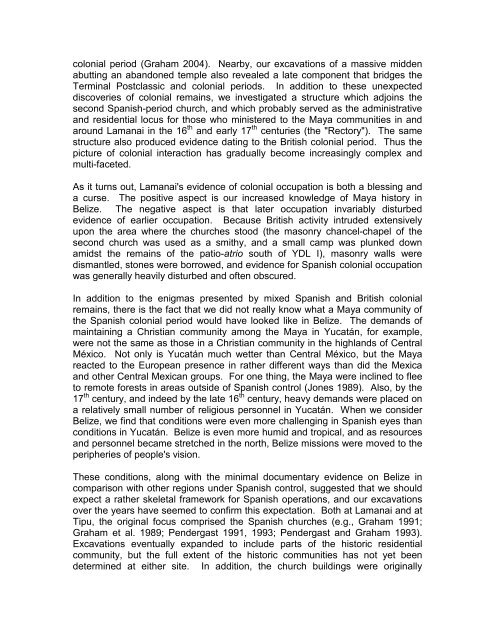Report submitted to FAMSI:
Report submitted to FAMSI:
Report submitted to FAMSI:
Create successful ePaper yourself
Turn your PDF publications into a flip-book with our unique Google optimized e-Paper software.
colonial period (Graham 2004). Nearby, our excavations of a massive midden<br />
abutting an abandoned temple also revealed a late component that bridges the<br />
Terminal Postclassic and colonial periods. In addition <strong>to</strong> these unexpected<br />
discoveries of colonial remains, we investigated a structure which adjoins the<br />
second Spanish-period church, and which probably served as the administrative<br />
and residential locus for those who ministered <strong>to</strong> the Maya communities in and<br />
around Lamanai in the 16 th and early 17 th centuries (the "Rec<strong>to</strong>ry"). The same<br />
structure also produced evidence dating <strong>to</strong> the British colonial period. Thus the<br />
picture of colonial interaction has gradually become increasingly complex and<br />
multi-faceted.<br />
As it turns out, Lamanai's evidence of colonial occupation is both a blessing and<br />
a curse. The positive aspect is our increased knowledge of Maya his<strong>to</strong>ry in<br />
Belize. The negative aspect is that later occupation invariably disturbed<br />
evidence of earlier occupation. Because British activity intruded extensively<br />
upon the area where the churches s<strong>to</strong>od (the masonry chancel-chapel of the<br />
second church was used as a smithy, and a small camp was plunked down<br />
amidst the remains of the patio-atrio south of YDL I), masonry walls were<br />
dismantled, s<strong>to</strong>nes were borrowed, and evidence for Spanish colonial occupation<br />
was generally heavily disturbed and often obscured.<br />
In addition <strong>to</strong> the enigmas presented by mixed Spanish and British colonial<br />
remains, there is the fact that we did not really know what a Maya community of<br />
the Spanish colonial period would have looked like in Belize. The demands of<br />
maintaining a Christian community among the Maya in Yucatán, for example,<br />
were not the same as those in a Christian community in the highlands of Central<br />
México. Not only is Yucatán much wetter than Central México, but the Maya<br />
reacted <strong>to</strong> the European presence in rather different ways than did the Mexica<br />
and other Central Mexican groups. For one thing, the Maya were inclined <strong>to</strong> flee<br />
<strong>to</strong> remote forests in areas outside of Spanish control (Jones 1989). Also, by the<br />
17 th century, and indeed by the late 16 th century, heavy demands were placed on<br />
a relatively small number of religious personnel in Yucatán. When we consider<br />
Belize, we find that conditions were even more challenging in Spanish eyes than<br />
conditions in Yucatán. Belize is even more humid and tropical, and as resources<br />
and personnel became stretched in the north, Belize missions were moved <strong>to</strong> the<br />
peripheries of people's vision.<br />
These conditions, along with the minimal documentary evidence on Belize in<br />
comparison with other regions under Spanish control, suggested that we should<br />
expect a rather skeletal framework for Spanish operations, and our excavations<br />
over the years have seemed <strong>to</strong> confirm this expectation. Both at Lamanai and at<br />
Tipu, the original focus comprised the Spanish churches (e.g., Graham 1991;<br />
Graham et al. 1989; Pendergast 1991, 1993; Pendergast and Graham 1993).<br />
Excavations eventually expanded <strong>to</strong> include parts of the his<strong>to</strong>ric residential<br />
community, but the full extent of the his<strong>to</strong>ric communities has not yet been<br />
determined at either site. In addition, the church buildings were originally
















